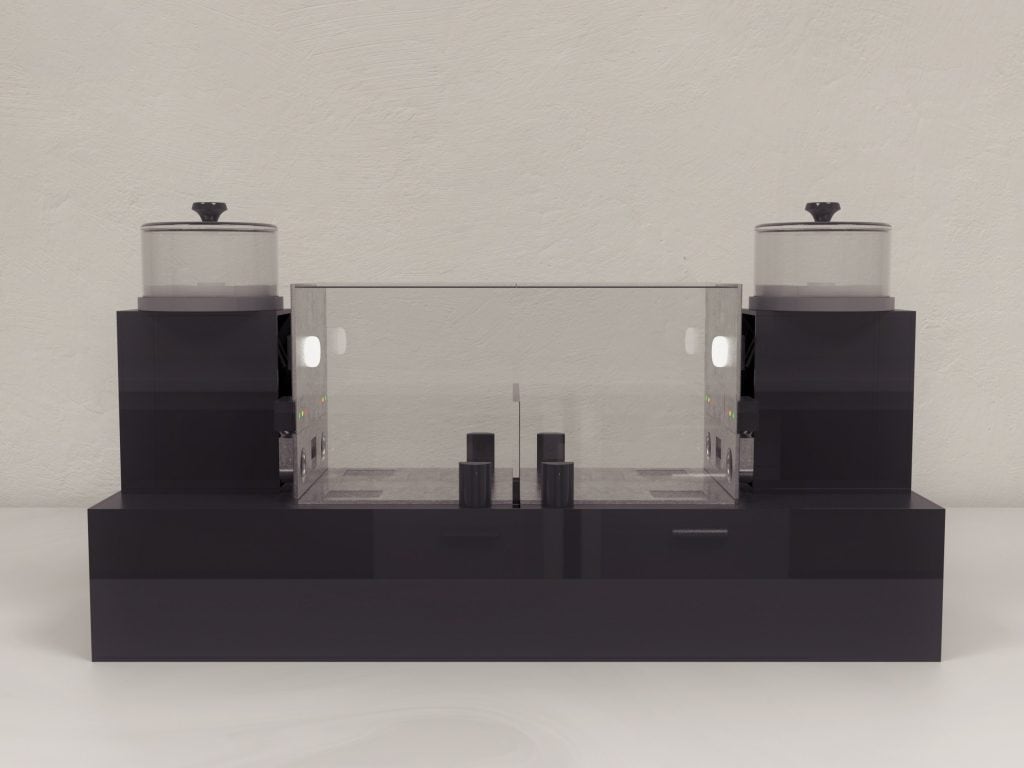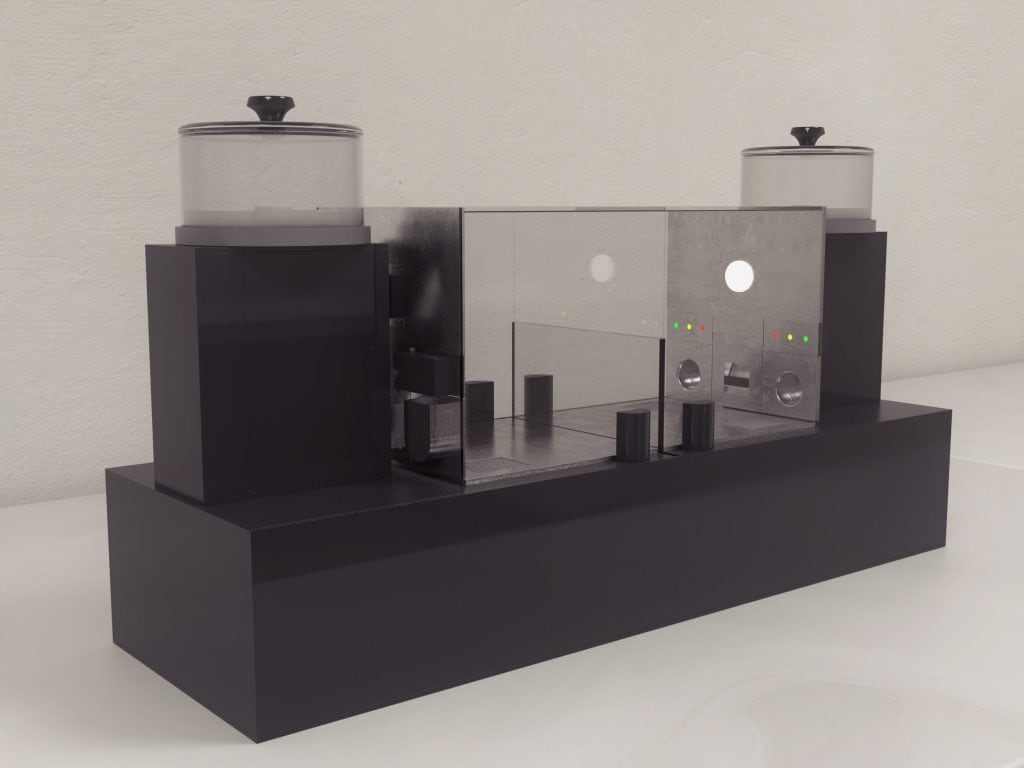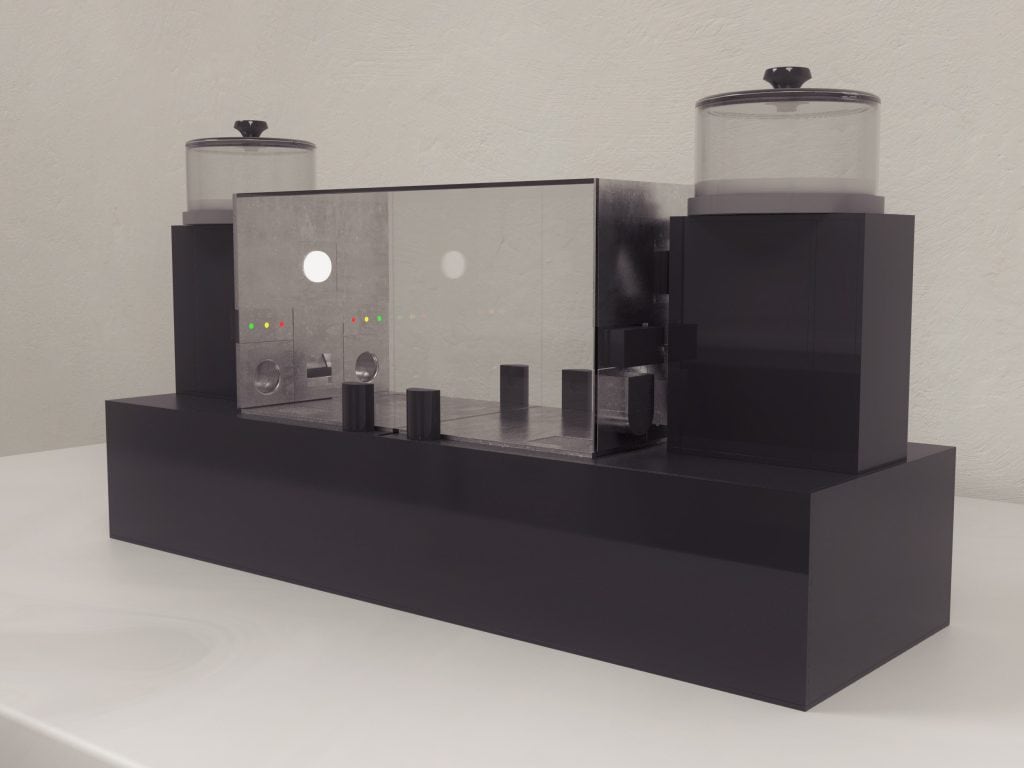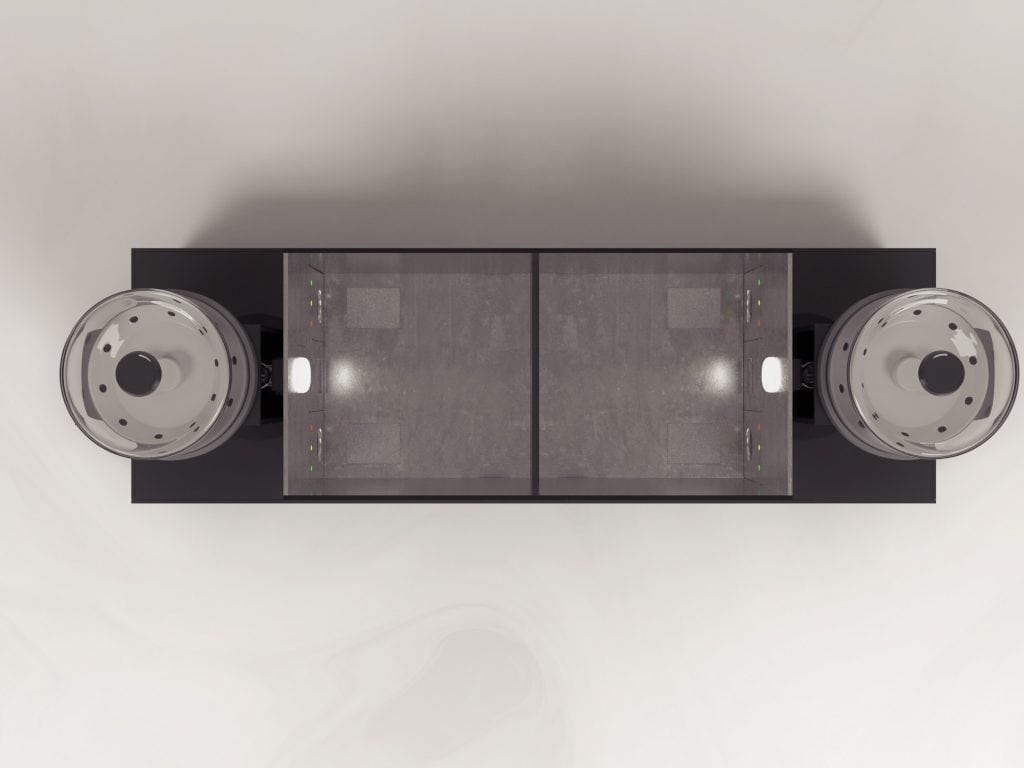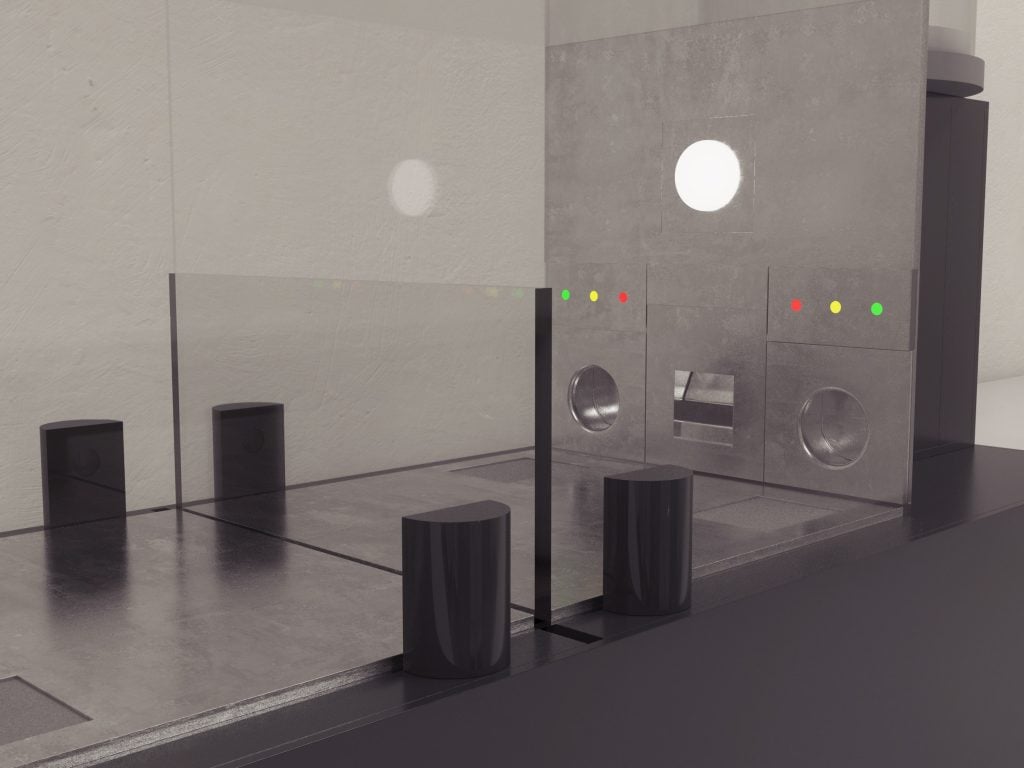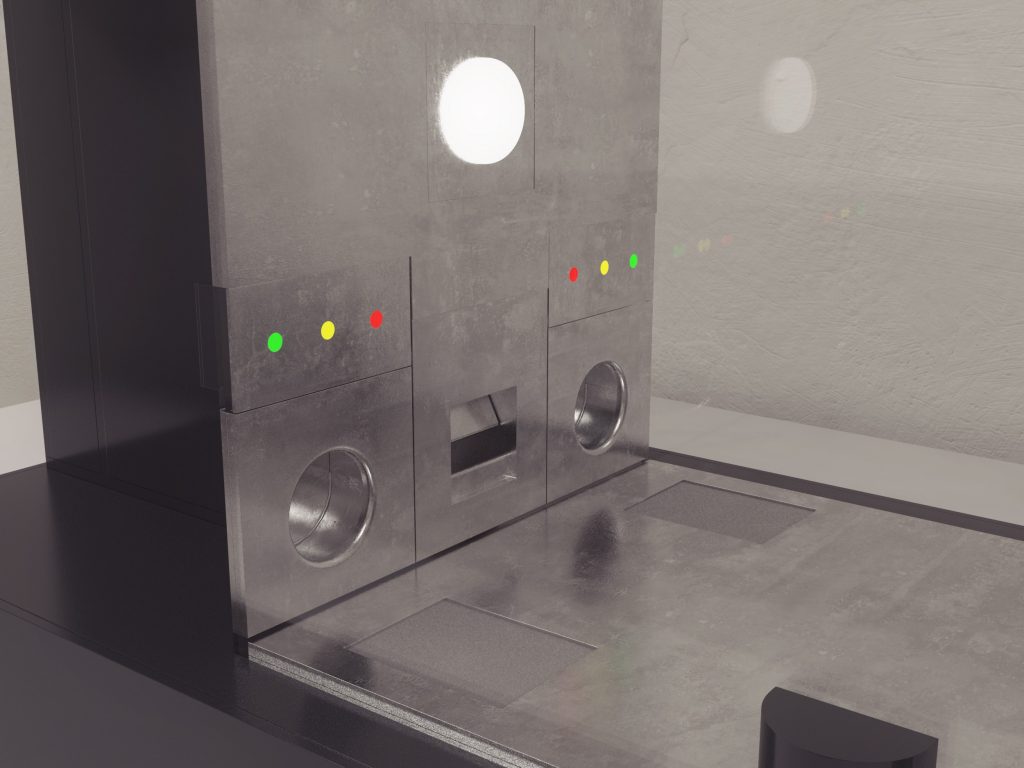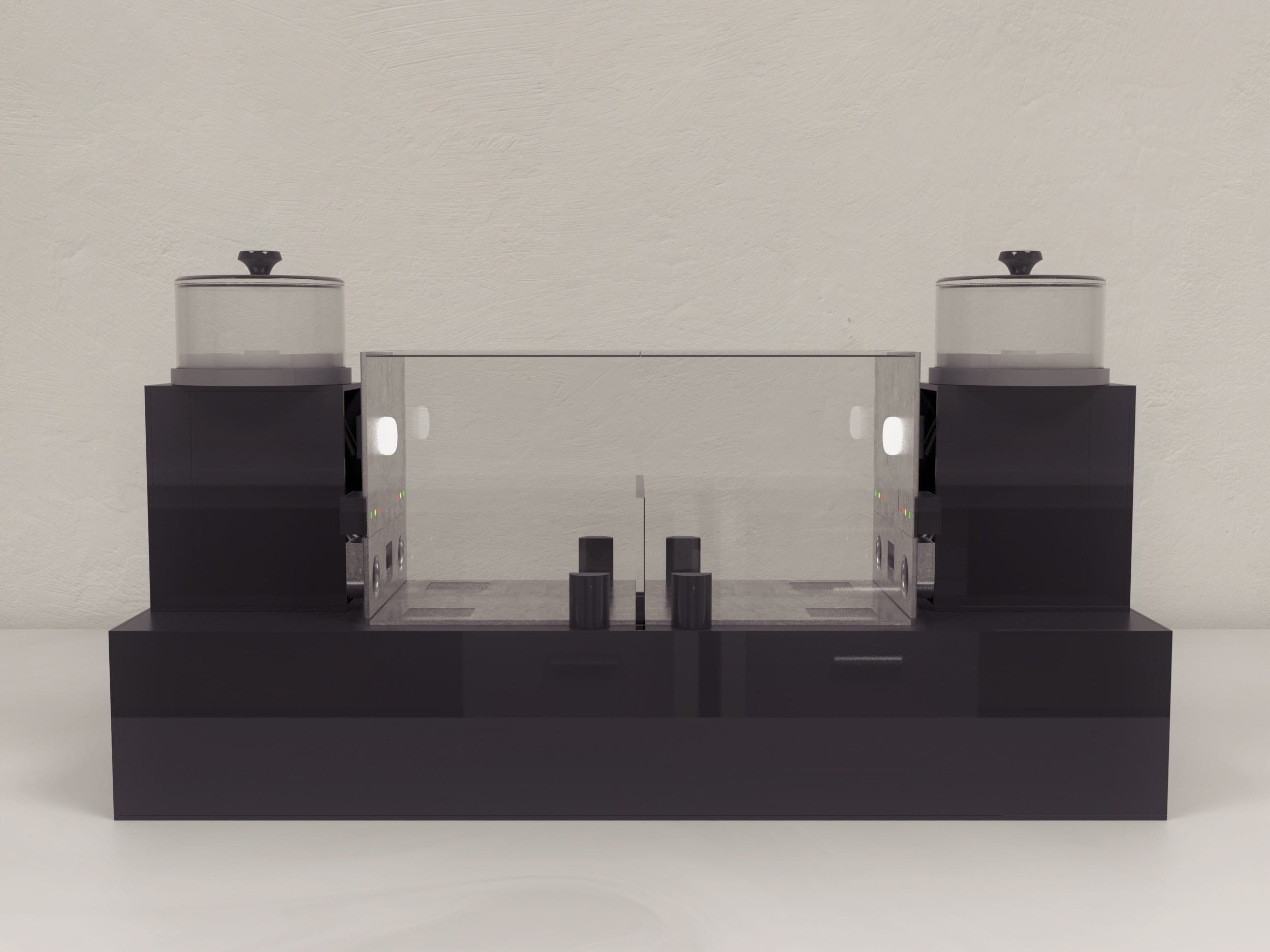
Description
The Operant IDED set shifting task chamber from MazeEngineers includes the following parts per chamber as listed below. Controlled using the Conductor software. The software collects and logs data while simultaneously allowing you to control the operant chamber and set up easy to configure experiments. Easy save for each experimental module you set up in Conductor, with integration to Ethovision and Neuralynx, and Pulsepal. Easy to modify for all future scenarios as well.
- Visual stimuli (2 LED’s)
- Food magazine
- Nose poke holes
- 2 Tactile stimuli
- Olfactory stimulus
- Automatic sliding door
- House light
- IR beam between the two chambers for door control
Features
Take advantage of Neuralynx, Ethovision Integration, SMS and Email integration with the Conductor Science Software. No I/O Boxes Required
Price & Dimensions
Mouse IDED chamber
$ 8900
+S&H- Single chamber size: 16cm x 16cm x 16cm
- Nose poke hole
- 2 LED visual stimuli (2) per side
- Food magazine
- tactile stimulus (2) per side
- House light
- Automatic sliding door with IR detection
Rat IDED chamber
$ 9900
+S&H- Single chamber size: 21cm x 21cm x 21cm
- Nose poke hole
- 2 LED visual stimuli (2) per side
- Food magazine
- tactile stimulus (2) per side
- House light
- Automatic sliding door with IR detection
Documentation
Introduction
The Operant Intra- and Extra-Dimensional Set-Shift Task is a behavioral test used in neuroscience to study executive function by assessing cognitive flexibility. Executive function refers to high-level cognitive processes including rule generation, behavioral selection, and strategy evaluation, and is primarily regulated by areas in the frontal cortex (Lie et al, 2006).
The Operant Intra- and Extra- Dimensional Set-Shift Task measures cognitive flexibility and executive function through the assessment of multiple cognitive abilities, including discriminative learning, reversal learning, attentional set-formation and attentional set-shifting, both within the same dimension (intra-dimensional shift) and between different perceptual dimensions (extra-dimensional shift). These abilities are used as a measure of (Keeler and Robbins, 2011). Response latencies can also be used as an index of speed of information processing, decision-making and problem solving (Robbins, 2002).
This test is a preclinical research version of the intra- and extra-dimensional attentional set-shifting (ID/ED), of the Cambridge Neuropsychological Test Automated Battery (CANTAB), used in humans to identify specific cognitive dysfunctions in a wide range of neurological and psychiatric disorders (Roberts et al, 1988).
Likewise, the Operant Intra- and Extra- Dimensional Set-Shift Task can be used to assess cognitive function in the context of neurological and psychiatric disorder models, as well as for drug and/or genetic screenings relevant to cognitive function with high relevance to translational medicine.
Rodent versions of these attentional set-shifting tests for primates have been previously generated (Birrell and Brown, 2000), but with several limitations, namely being manually run and therefore highly labor-intensive and difficult to standardize. This automated version overcomes those major limitations and increases the throughput of testing.
Apparatus & Equipment
The apparatus consists of two identical chambers separated by a transparent dividing door that can be automatically controlled to allow the animal to move between chambers. Each chamber has two nose-poke holes with infrared photo beams, and, between them, a food receptacle with photo beams where a pellet dispenser delivers the food reinforcement.
Each nose-poke hole can be equipped with multiple changeable stimuli varying in three perceptual dimensions (odor, sight, tact). To deliver olfactory stimuli into the nose-poke holes, a dilution olfactometer is used to automatically control the presentation of pairs of scents to the nose-poke holes. For visual stimuli, light-emitting diodes (LED) are placed on top of each nose-poke hole. For tactile stimuli, changeable floor textures can be mounted on a sliding support in front of each nose poke hole. A camera is placed on the top of the apparatus in order to record basal alternation and locomotor activity. The presentation of the stimuli and data collection can be performed using the Noldus EthoVision® XT software.
Training Protocol
The purpose of the Operant Intra- and Extra-Dimensional Set-Shift Task is to assess executive function and cognitive flexibility in rodents in a control vs. disease model/intervention group, by assessing strategy shifting and/or reversal learning.
There are several versions of protocols to be used with the Operant Intra- and Extra-Dimensional Set-Shift Task, depending in the specific behavioral assessment to be made.
Below are examples of protocols that allow the assessment of different aspects of cognitive flexibility, as described for mice. A more detailed version of these protocols can be found in Scheggia and Papaleo F, 2016.
Pre-training for the Operant Intra- and Extra-Dimensional Set-Shift Task
Animals can be housed individually or in groups, depending on the experimental needs. Single housing should be used for experiments requiring food-restriction, such as to allow a better control of food intake.
After a few days of habituation to the testing facilities, without handling or food restriction, animals should be handled daily for around 5 min, and for at least 3-5 days before beginning behavioral testing.
The animals’ weight should be recorded on the first day of handling, when food restriction begins. Over the days of handling, animals’ daily food intake should be gradually reduced to bring them to a target weight of 85-90% of their initial weight. At the end of each handling session, 10-20 reward pellets should be placed in the animal’s cage to habituate them to the reinforcement that will be used in the tasks.
Each animal should always be tested at approximately the same time of day.
Dimensional Set-Shift Task
Training
Training 1 (day 1) – Place the animal in the apparatus with the dividing door open for 40 min; use only neutral stimuli (see Table 1) for all different dimensions; each nose-poke in any nose-poke hole results in a pellet delivery in the food receptacle.
Training 2 (day 2) – Place the animals in the apparatus with the dividing door closed; use only neutral stimuli for all different dimensions; each nose-poke in any of the nose-poke holes results in a pellet delivery in the food receptacle; when the mouse retrieves the reward, open the dividing door to give the mouse access to the other chamber for the next trial; repeat for 40 min.
Training 3 – Train the animals to perform two simple discriminations (SD1 and SD2; e.g., peach vs. sage; velcro vs. film; light cue on vs. light cue off) to a criterion of 8 correct responses out of 10 consecutive trials. The animal must learn to choose the nose-poke hole where the correct stimulus is presented. Do not use the same stimuli again during the next phases of the test.
- Place the animal in one chamber with neutral stimuli; turn on stimuli cues in the other chamber; open the door to give access to the chamber with the stimuli.
- Reward a nose-poke in the correct hole with a pellet delivery; when the animal enters the food receptacle, open the dividing door to give access to the other chamber for the next trial; for a nose-poke in the incorrect hole, do not reward and turn the house light on for 5 sec; the door is then opened to give the mouse access to the other chamber for the next trial.
- Conduct the first ten trials of each stage as shaping trials: if the mouse selects the incorrect hole, record an error but do not terminate the trial until the mouse pokes also in the correct hole. In subsequent trials, if the mouse pokes in the incorrect hole, record an error and turn off all dimensional stimuli to terminate the trial.
- Terminate each session after 40 min or if an animal fails to make any response for five consecutive minutes. If the animal does not reach the criterion in one session, continue the test on the next day.
- If an animal cannot reach the criterion in the SD1 or SD2 after 5 days, stop testing it and eliminate it from the study.
Testing
Stuck-in-set ID/ED Paradigm Procedure
In the stuck-in-set paradigm, three different perceptual dimensions are manipulated; all sessions start by placing the animal in a chamber with neutral stimuli. Before the beginning of a trial, the stimulus cues are switched on in the opposite chamber. Then the dividing door is opened to give access to the other chamber where the stimulus cues are on. A “relevant dimension” is the one containing the correct option.
- Train the animal to develop a set, or bias, toward a particular perceptual dimension (odor, light or floor texture) by exposing it to the following discriminations presented in this order (see Figure 1):
- Simple discrimination (SD): introduce animal to a dimension (odor, light or texture) that is relevant in all the tasks until the EDS; e.g present two odors, such as vanilla (O1) and lavender (O2), and select O1 as the correct response.
- Compound discrimination (CD) – introduce a second dimension, e.g. light, which is irrelevant; present two lights (L1 and L2) together with the odors (O1 and O2) in order to have two possible discriminations. The correct and incorrect stimuli are the same as in SD.
- Reversal of the compound discrimination (CDRe) – leave the stimuli and the relevant dimension unchanged, but have the animals learn that the previously correct stimulus is now incorrect; e.g. select lavender as the correct response, with vanilla being now the incorrect choice.
- Intra-dimensional shift (IDS) – new stimuli are introduced for both the relevant and irrelevant dimensions (a total change design); e.g. use strawberry and cinnamon (O3 and O4) as the odors and blue and yellow lights (L3 and L4) as the lights; keep the correct option in the same relevant dimension.
- Reversal of the intra-dimensional shift (IDSRe) – repeat c).
- Intra-dimensional shift 2 (IDS2) – repeat d).
- Intra-dimensional shift reversal 2 (IDSRe2) – repeat c).
- Extra-dimensional shift (EDS) – replace previously irrelevant stimulus dimension by a new stimulus dimension (texture) which becomes relevant; present a pair of stimuli from the new dimension, e.g. coarse sandpaper (T1) as the correct response and fine sandpaper (T2) as incorrect, and present two new odors, e.g. lemon and apricot (O7 and O8); the previously relevant dimension has now become irrelevant; do not present the previously irrelevant dimension anymore.
- Extra-dimensional reversal (EDSRe) – repeat c).
Two-dimension ID/ED Paradigm Procedure
The two-dimension paradigm is another condition to measure attentional set-shifting. In this case, only two perceptual dimensions are used throughout the test.
- Use the order of the discriminations and the procedure to follow as described for the stuck-in-set protocol up to the EDS stage (see Figure 1):
- SD to IDS2Re – same protocol as in a) to g) in the stuck-in-set paradigm.
- EDS – the previously irrelevant dimension (light) now becomes the relevant dimension; the previously relevant dimension (odor) is now the irrelevant one.
- EDSRe – the relevant dimension is the same as in the EDS but the correct and incorrect stimuli are inverted.
For both paradigms:
- Measure the animal’s performance until it reaches a criterion of 8 correct choices out of 10 consecutive trials to complete each stage. Stop a daily session after 40 min; if an animal fails to make any response for 5 consecutive minutes, terminate the session and continue the next day on the same stage.
- For each stage, measure the trial to criterion and time to reach the criterion (in minutes). If criterion is not reached in one session, sum up the total time taken in consecutive sessions; for each trial, also measure the time from presentation of the stimuli (odors, lights, textures) to a nose-poke response (latency to respond).
- At the end of each session, clean the apparatus with 70% alcohol.
- Use always the same order of the discriminations; however, randomly change the stimulus dimensions and the pairs of stimuli used; equally represent them within experimental groups and counterbalance them between groups; equally counterbalance the perceptual dimensions used within and between each experimental group so that each possible ED shift is represented (i.e., light to odor, light to texture, odor to light, odor to texture, texture to light, texture to odor).
Table 1 – Examples of stimuli used in the operant intra- and extra- dimensional set-shift task. From Scheggia and Papaleo F, 2016; originally published in Scheggia et al 2014. Selected stimuli should elude any confounding factor and/or bias due to avoidance or preference. Five pairs of stimuli for each dimension allow a within-subject testing of all shifts, with novel stimuli at every shift.
| ODORS | TEXTURES | LIGHTS |
| peach v. sage | velcro v. film | lights on v. lights off |
| vanilla v. lavender | coarse sandpaper v. fine sandpaper | red v. green |
| strawberry v. cinnamon | smooth cardboard v. ridged cardboard | blue v. yellow |
| grapefruit v. oregano | sponge v. smooth plastic | orange v. white |
| lemon v. apricot | honeycomb paper v. aluminum foil | fix lights v. blinking lights |
| neutral: air flux with no scent | neutral: white paper | neutral: no light |
Image 1 – Example of the stuck-in-set and two-dimension paradigms. From Scheggia and Papaleo F, 2016, as adapted from Scheggia et al 2014.

Modifications
Different versions of the Operant Intra- and Extra-Dimensional Set-Shift Task have been used (e.g. Birrell and Brown, 2000), but with several limitations, namely being manually run and therefore labor-intensive and difficult to standardize. This automated version overcomes those major limitations and increases the rate of data collection and throughput.
Sample Data
The data obtained with the Operant Intra- and Extra-Dimensional Set-Shift Task can be visualized by graphing, for each stage, trials to criterion, time to criterion, or latency to respond. Below are presented example graphs showing the effect of a disease model on those behavioral measures. Further examples can be found in Scheggia and Papaleo F, 2016 or in Scheggia et al, 2014.



Using graphs similar to these to compare behavioral flexibility between control and disease or treatment groups allows for easy visualization of the effects on executive function. Animals with impaired cognitive flexibility (due to a neurological disorder, for example) may take longer to reach criterion and have a higher response latency.
Strengths and Limitations
The main strength of the Operant Intra- and Extra-Dimensional Set-Shift Task is the possibility of performing multiple behavioral assessments associated with cognitive function. This automated version of the task dramatically improves the rate of data collection and throughput and eliminates subjectivity in the analysis.
Keep in mind that experiments entailing food restriction may require specific approval of an institutional regulatory body before any procedures may begin.
Summary and Key Points
- The Operant intra- and extra- dimensional set-shift task can be used to test cognitive flexibility as an index of executive function.
- This test assesses reversal learning, attentional set formation and shifting, speed of information processing, decision-making and problem solving.
- Different groups have adapted this test in order to collect data regarding different aspects of cognitive flexibility.
- Animals with neurological of psychiatric disease models may show impaired cognitive flexibility.
- The Operant Intra- and Extra-Dimensional Set-Shift Task has been used to study cognitive mechanisms and the effect of diseases and treatments on executive function
References
Birrell JM, Brown VJ (2000). Medial frontal cortex mediates perceptual attentional set shifting in the rat. J Neurosci, 20(11):4320-4.
Keeler JF, Robbins TW (2011). Translating cognition from animals to humans. Biochem Pharmacol, 81(12):1356-66.
Lie, CH et al (2006). Using fMRI to decompose the neural processes underlying the Wisconsin Card Sorting Test. NeuroImage, 30:1038-1049.
Robbins, TW (2002). The 5-choice serial reaction time task: behavioural pharmacology and functional neurochemistry. Psychopharmacology. 163(3-4):362-80.
Roberts AC, et al (1988). The effects of intradimensional and extradimensional shifts on visual discrimination learning in humans and non-human primates. Q J Exp Psychol B, 40(4):321-41.
Scheggia D, et al (2014). The ultimate intra-/extra-dimensional attentional set-shifting task for mice. Biol Psychiatry, 15;75(8):660-70.
Scheggia D, Papaleo F (2016). An Operant Intra-/Extra-dimensional Set-shift Task for Mice. J Vis Exp, (107):e53503.

